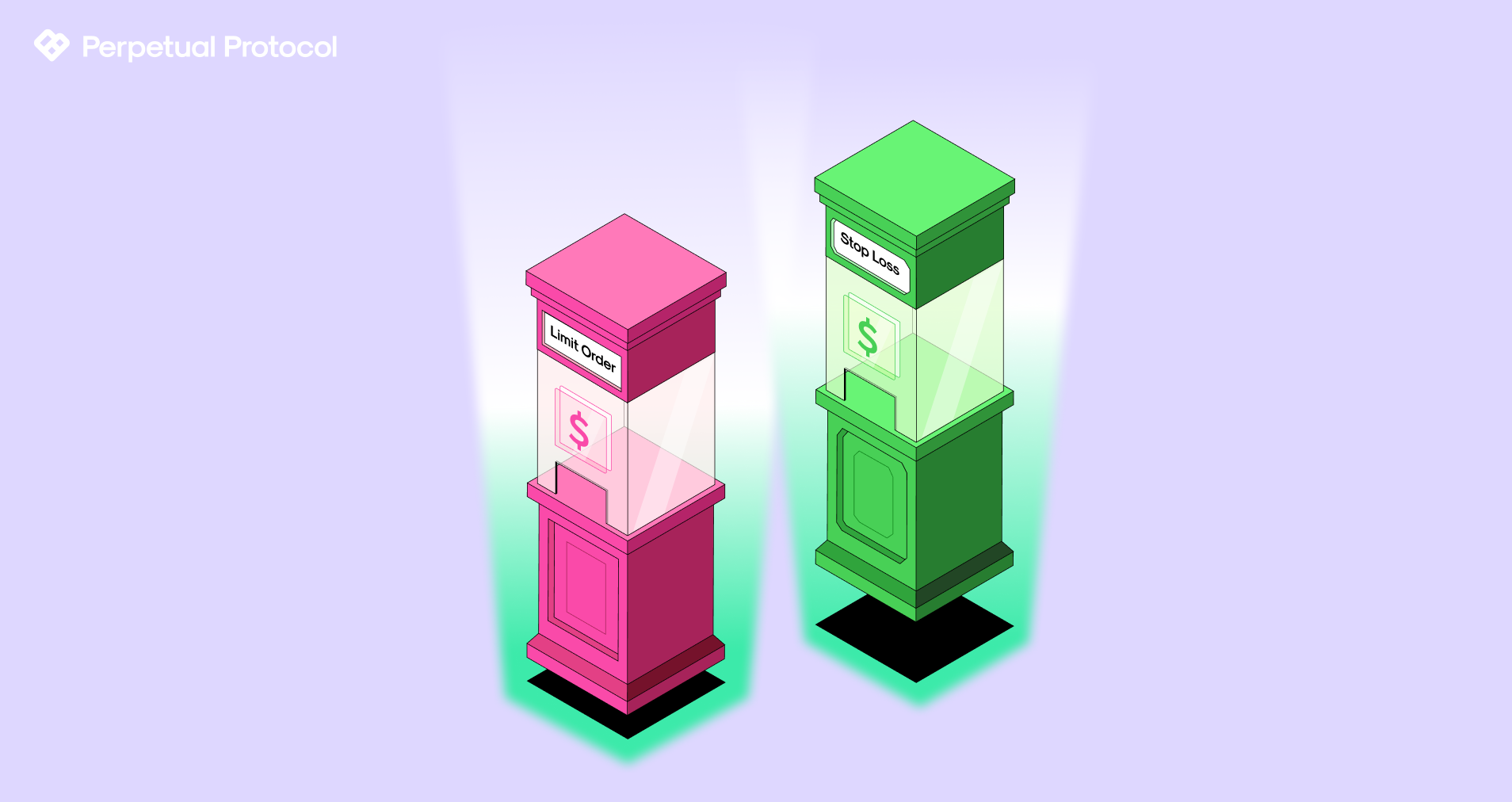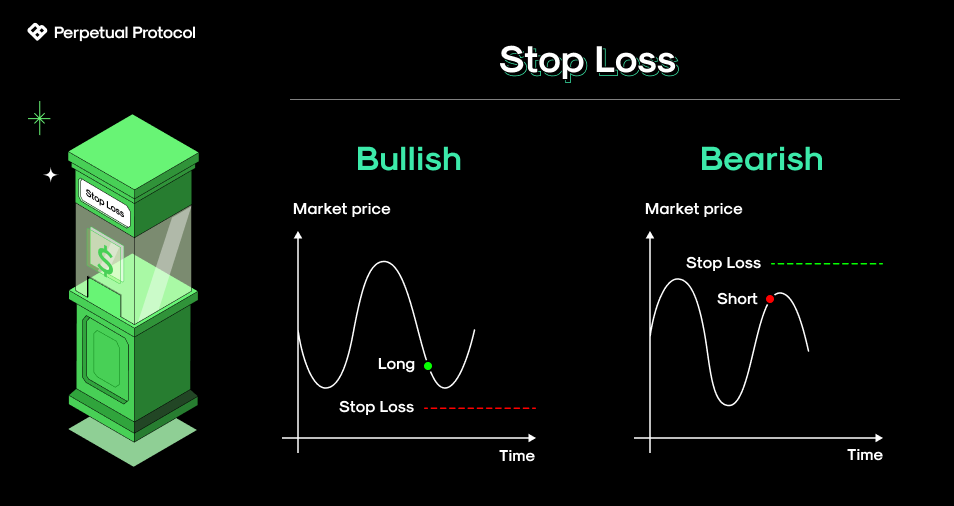
The most anticipated update to Perpetual Protocol has arrived: advanced order types!
With the introduction of limit and stop loss orders, traders can now enjoy more advanced strategies and improved risk management.
What are Limit Orders?
Limit orders differ from market orders, as you can specify the price level (known as the limit price) at which you want to buy or sell an asset. The order will then be executed at a price equal to or better than the limit price.
The chart below shows how traders can use limit orders depending on whether they’re bullish or bearish:

While market orders prioritize time, limit orders prioritize price
Limit orders guarantee a certain execution price, however, they do not guarantee that your order will be filled. The upside is better execution. The downside is that if the limit price is not reached, then the order may never be filled and you may miss a major price move that you were anticipating.
Also, for limit orders to be executed successfully, there must be sufficient liquidity around the specified limit price. If there’s insufficient liquidity to fill your position, then the order may not be executed at all.
Each order type has its own benefits in different situations: if you expect a large price move to occur imminently, then a market order is probably the better option. On the other hand, if you think there’s an underlying price trend that might have some momentum left in it before a reversal occurs, then it’s better to use a limit order.
Limit Order Example
Let’s say the current index price of ETH-USD is $1,200.
You think there’s a high likelihood that the current downtrend will soon be exhausted and the market will bounce upwards once ETH-USD tags the $1,000 level.
To prepare for this possibility, you can place a limit order to buy around $1,000.
Several limit orders can be submitted both above and below the $1,000 level to ensure at least one of them are filled. Let’s say you set a limit price to buy at $1,000. Once the mark price drops below the $1,000 level, this triggers a market order to buy and automatically opens a long position.
Limit orders can also be used to close out positions at a profit. For example, after entering a long ETH position at $1,000, a limit order to sell around $2,000 will automatically exit the position and realize a profit, without having to actively monitor the market or manually close the trade.
Reduce-Only Option
There’s also a reduce-only option for limit orders, which can be used whenever you want to reduce the size of an open position. For example, if you are long ETH-USD, you can use a reduce-only order to sell to make sure it only partially or fully closes the existing long position.
Let’s say that you currently hold a long position in ETH, with an entry price of $1,800. You can use a reduce-only limit order to sell at $2,500. This order will only reduce your existing position.
How Limit Orders Work on Perp v2
Limit orders can now be submitted through our UI, API, or smart contract.
To learn more about how limit orders work on Perp v2, check out our help center article.
Along with limit orders, we have also launched stop-loss limit orders!
What is a Stop Loss?
The stop-loss limit order type can be used as a stop loss to close a position at a specified price. As the name suggests, this order type is generally used to cut losses and stop losses on Perp v2 are a combination of a limit order and a stop order. Once the index price reaches the stop-loss limit order’s trigger price, a limit order is placed at the limit price to close out an existing position at a pre-set loss.
Trading is a long game and becoming profitable is a matter of managing losses so that you can grow your capital. Stop losses help traders to achieve this by automatically closing unprofitable positions and cutting losses before they deplete too much of your capital.
The diagram below illustrates how stop losses can be used after entering a long or short position. If you’re using a trend following strategy, then usually stops are placed somewhere beneath the lower low of the market structure, as displayed above.

Stop losses are not solely for cutting losses, though, you can also use them to ensure that you always exit a position trade with a profit.
For example, if you go long and the price keeps going up, then you can move your stop loss up further in step with the market. That way, if the market reverses, the position is closed out at a profit once the trigger price has been hit.

The same concept also applies to limit orders: you might be bullish on ETH and waiting for it to hit a certain price level, so you submit a limit order to buy at $1,000. But then some new information comes into play suddenly and changes the market sentiment, which causes the price of ETH to drop. You can cancel the existing limit order and submit a new one to buy near $900.
Cutting Losses: Stop Loss Example
Let’s say you’re long 0.5 ETH with an average entry price of $1,200. You anticipate that the market will remain bullish as long as the $1,000 holds.
To manage your risk and prevent the position from losing more than $100, you can set a stop loss around $1,000. For the scenario where the price falls below $1,000, you’ll have limited your losses and until it happens, you can rest easy, knowing that the maximum loss you’re comfortable with will only be $100.
However, if the price moves sharply higher from $1,200 to $1,600 after opening the long. You can now move the stop limit order up to $1,200 to ensure that no matter what happens, you’ll break even on the trade and incur no losses. Or you could move it up further to lock in profits (but with less breathing room) if the price moves lower.
If the price dives back down, the stop loss order acts like an airbag, saving you from a negative PnL for this position or guaranteeing a positive profit.
Benefits of Advanced Order Types
-
Better execution in times of high volatility: Limit orders can help traders to avoid unfavorable entries/exits due to highly volatile market conditions. Since market orders execute immediately at the best available price, and if the price is moving around rapidly, it’s more uncertain at which price you’ll actually get an entry.
- The price of ETH is fluctuating between $1,600 and $1,400 over a very short time, and let’s say you’re bullish. You could use a market order as the price nears $1,400 but ends up getting filled nearer $1,500 due to market conditions. When using a limit order, you can simply set a limit price = ~$1,400 to improve the entry.
-
Automate your trading: Instead of waiting for the best time to submit a market order, you can set and forget a limit order at the price you’re comfortable buying or selling at. That means you don’t have to worry about timing tops or bottoms in the market.
What’s Next?
By introducing these new advanced order types, Perp v2 is getting ever closer to its goal of matching the functionalities of centralized exchanges
Next up on the roadmap: a new tokenomic model for PERP and then permissionless markets.
Links
Translations of this article are available in Español, Hindi (हिंदी), Mandarin (普通话), Swahili, and Thai (ไทย), thanks to the help of our Perpvangelists!